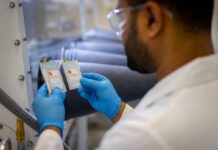Researchers at the University of Pennsylvania have developed a novel concrete formulation that captures more carbon dioxide than traditional mixes, while reducing the amount of cement required.
By combining 3D printing techniques with fossilised microscopic algae known as diatoms, the research team created a lightweight yet structurally sound concrete that can absorb up to 142per cent more CO2 than conventional concrete.
The findings, published in Advanced Functional Materials, highlight the potential for reducing greenhouse gas emissions from a material that currently contributes up to 9 per cent of global emissions.
The key component of the innovation is diatomaceous earth (DE), a porous, silica-rich substance made from fossilised diatoms.
The University of Pennsylvania team found that DE improves the material’s flow during 3D printing while creating ample surface area for carbon dioxide to bind and react.
“Usually, if you increase the surface area or porosity, you lose strength,” said Professor Shu Yang, Chair of the Department of Materials Science and Engineering at the University of Pennsylvania. “But here, it was the opposite; the structure became stronger over time.”
The research demonstrated that when the concrete’s geometry was optimised, it achieved an additional 30 per cent increase in CO? conversion while maintaining compressive strength comparable to traditional concrete.
The team used triply periodic minimal surfaces (TPMS), natural geometries found in bones and coral, to maximise surface area while using 68 per cent less material than standard concrete blocks.
Professor Masoud Akbarzadeh, associate professor of architecture at Penn’s Weitzman School of Design, said the team was able to reduce the material used by nearly 60% without compromising load-bearing capacity.
“It was about unlocking a new structural logic,” he said. “We showed it’s possible to do much more with much less.”
Lead researcher Kun-Hao Yu, a former postdoctoral researcher at Penn, developed the printable concrete ink by adjusting variables including water-to-binder ratios and extrusion speed. He noted that despite the high porosity, which typically weakens materials, the new concrete formulation gained strength as it absorbed CO?.
The structure’s internal geometry was designed using polyhedral graphic statics, a technique used to map force distributions. Post-tensioning cables were added to further enhance internal stability, allowing for steep overhangs and open designs that expose more surface area to the air.
Laboratory tests showed that the printed components retained 90% of the strength of solid blocks while increasing CO2 uptake per unit of cement by 32 per cent. The researchers say the design could be applied to architectural-scale components such as facades, floors, and structural panels.
“We’re testing larger components with more complex reinforcement schemes,” said Akbarzadeh. “We want these to be not just strong and efficient, but buildable at architectural scale.”
The team is also exploring applications in marine infrastructure, where the porous material could support artificial reefs or oyster beds while passively capturing CO2 from surrounding water.
“The high surface area helps marine organisms attach and grow,” said Yang. “And the material passively absorbs CO2, which could make it ideal for restoration projects.”
In parallel, the University of Pennsylvania researchers are investigating alternative binder systems to replace conventional cement entirely, including magnesium-based and alkali-activated materials. Yang said the goal is to push the technology further and reduce reliance on carbon-intensive cement manufacturing.
“The moment we stopped thinking about concrete as static and started seeing it as dynamic—as something that reacts to its environment—we opened up a whole new world of possibilities,” she said.





















